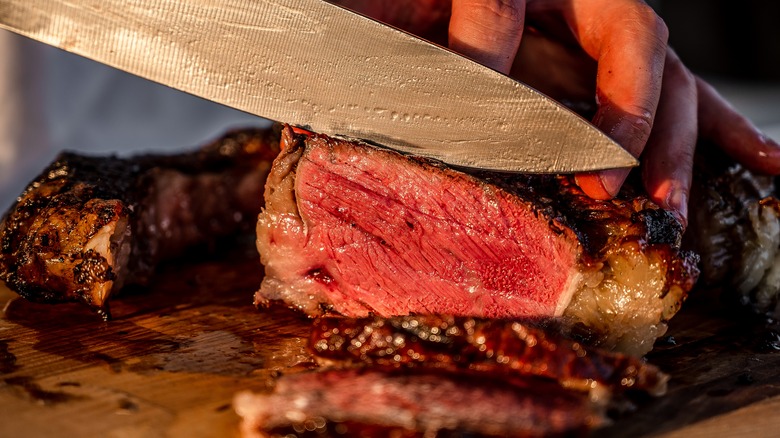Upgrade Your Next Steak Dinner With A Slow Salt Brine
Be forewarned: The following upgrade is not a time-saving measure for elevating steak. We're talking about slow salt brining. And when we say slow, we mean slow – as in you're going to need to come up with at least another night's worth of dinner before you have the opportunity to enjoy your salt-brained steaks.
Also known as dry brining, salt brining is a seasoning technique that applies liberal amounts of salt directly to a steak. The big trick with salt brining, however, is the length of time the salt is allowed to stay in contact with the steak. Let's just say that a two-day brine in the fridge is not out of the question. However, anywhere from eight to 16 hours should be sufficient for a good salt-brine.
The reason the salt stays on the steak for so long is so it has time to do its job and properly brine the steak. Brines work to break down and tenderize meat, injecting flavor and bringing about a softer texture. And while dry brining doesn't involve liquid of any kind, it still does its part to bring about a change in the steak — one that ultimately leads to a more pleasurable eating experience.
How salt brining benefits steak
Salt brines work best on steaks thick and fatty enough to stand up to the time it takes to work properly like ribeyes or NY strips. It does wonders for them both, primarily because the salt helps bring out their natural beefy flavors. As the salt sits, it will draw out the moisture of the steak. The salt will then melt and begin to pool on top of the meat. Leaving the steak for a longer brine allows those juices to be reabsorbed into the meat. So not only will you have a properly seasoned steak, but you'll have one that is incredibly juicy to boot.
Thanks to this moisture getting locked into the steak, you are going to end up getting an exceptional crust as a result. Known as the Maillard reaction, a dry surface is required for it to do its magic best. As the salt is drawn back in with the steak's natural juices, the surface is left relatively dry. Therefore, getting a great sear on the steak is going to be far easier.
Finally, you get that tenderization. Those essential juices are released from the steak as a result of the salt working to break down the steak's proteins. The surface is left porous and allows for those juices to come right back in. So, what you get for your patience is a really outstanding, flavorful, and tender piece of meat that is well worth the multi-hour, or multi-day wait.

